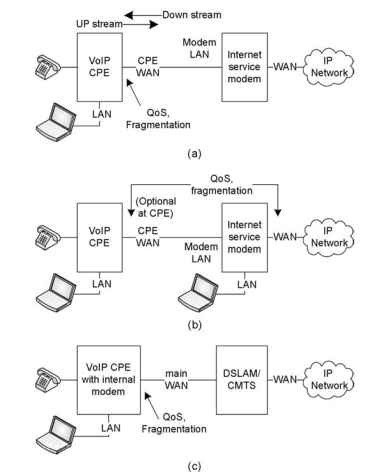VoIP voice calls make use of Internet service. End-to-end packet delivery on an Internet Protocol (IP) network can face impediments. Voice packets are smaller, and data packets can be bigger in byte size. As explained in topic 2, VoIP customer premise equipment (CPE) also has a wide area network (WAN) interface and several local area network (LAN) interfaces. The WAN interface is the main outlet on CPE for connectivity to the Internet. As shown in Fig. 18.1(a), the CPE WAN interface is terminated on another main LAN interface of an Internet service modem [e.g., digital subscriber line (DSL) or cable]. As shown in Fig. 18.1(a) and Fig. 18.1(b), the LAN interface and some applications in CPE can send large data packets along with voice. These large packets can introduce delay and delay variations (jitter) to voice packets. The effect of jitter is mainly dominant with limited bandwidth physical interfaces. For completeness of the representations, Fig. 18.1(c) is included that conveys the usage of VoIP CPE with built-in direct WAN connectivity. This direct WAN connectivity could be DSL or cable. In this topic, a DSL physical interface is considered for creating example calculations with bandwidth limits; however, similar conditions are also applicable with other interfaces. Many residential applications use DSL service. Various options in DSL service exist, which range from 256 kbps to several 100 Mbps of bandwidth support. In the lower end basic residential service, DSL upstream bandwidth is usually limited to 256 to 768kbps. As marked in Fig. 18.1(a), upstream is for sending packets from VoIP CPE to the external IP network. The data from the external network

Figure 18.1. Representations of LAN and WAN connectivity. (a) VoIP CPE connected to another ISP modem. (b) VoIP CPE with ISP modem and data path shown at VoIP CPE and ISP modem. (c) CPE with built-in modem.
to the CPE is the downstream. ADSL2+, and a very high-speed DSL (VDSL) based service, gives more bandwidth than simple DSL, and the issues highlighted in this topic are not applicable to these wideband interfaces. In many countries, residential users may get limited bandwidth because of limitations in availability of service options. Users may also opt for lower bandwidth service to reduce the expenses or because of their limited usage of the Internet. When VoIP calls are used with limited bandwidth service, VoIP calls occupy a significant part of available bandwidth. Many Internet-based applications and LAN data traffic generate large (e.g., 1514 byte) packets. IP quality of service (IPQoSs) prioritizes voice packets by holding low-priority large data packets. Once large data packets are scheduled, a scheduler may not preempt these large packets. Voice packets will join behind the large scheduled data
packets. As an example, for a DSL upstream bandwidth of 256 kbps, a scheduled 1514-byte data packet can delay voice packets up to 53 ms. In the absence of large packets, this delay is not present to the voice packets. This delay varies between 0 and 53 ms, appearing as jitter that makes destination jitter buffers grow in size. In this situation, depending on the jitter buffer design, packets will be dropped or jitter buffer conditions will increase the end-to-end delay by approximately 53 ms. Both packet drop or buffer growth can degrade voice quality significantly.
In a bandwidth-constrained packet network, it is not possible to eliminate packet delay variations, but large packets can be fragmented to multiple smaller packets to limit the delay variations to less than 10 ms. Fragmentation divides a large packet into multiple smaller packets. Once large packets are fragmented, voice packets are interleaved with the fragmented small data packets, which reduce the delay variation. At the receiver, fragmented smaller packets are reassembled for creating the original large packet. In this topic, various DSL upstream bandwidth rates, packet delay variations, and suggested fragmentation sizes to limit jitter to less than 10 ms are presented. In general, no set mandatory goals have been placed on this 10 ms. In practice, most service providers would accept a delay increase of the order of 10ms. Some specific DSL examples are given in the subsequent part of this topic.
VOICE PACKETS JITTER WITH LARGE DATA PACKETS (VoIP)
Next post: VoIP ON PERSONAL COMPUTERS
Previous post: ATM CELLS AND TRANSMISSION (VoIP)
